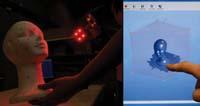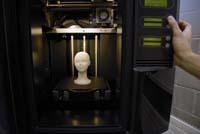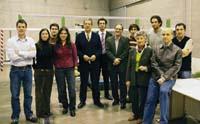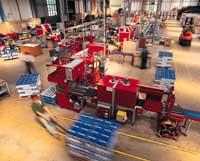The reverse path of engineering
2007/11/01 Kortabitarte Egiguren, Irati - Elhuyar Zientzia Iturria: Elhuyar aldizkaria

Suppose also that there has been a fire in a company and all plans have been lost. All machines, parts or tools in the company must be recovered. It is also very useful in these cases. What do they do in these cases? They take the piece and scan it.
Tip scanner
In the laboratory they have a laser pointer scanner. This scanner is mobile, that is, you can scan any part in any position, as it can be moved manually. In addition, the size of objects is not a problem, as large pieces can be fractioned. The only limitation is that the scanner has to do in some way. To do this, they add references to the object to be digitized, setting a reference system to the object. This scanner uses laser technology to digitize the surface of the object. As the laser beam moves across the surface of the object, the scanner reads the coordinates of the surface points. It is capable of reading 18,000 points per second, allowing you to scan the total surface of the object in a few minutes. While scanning is finished, the completed point cloud is displayed on the computer screen.
The scanner uses software to process points received and complete the point cloud. Using this software also allows you to modify the accuracy of the point cloud as well as other features, eliminating unnecessary noise or data from the original point cloud.
To edit this point cloud obtained use Geomagic software. This software fixes potential points cloud holes and errors. And it also allows to transform and improve the model, correct errors presented by the original object or add new components to the model, etc.

3D photocopy
When the model is ready, it is exported in CAD format to the light prototype machine. This machine manufactures plastic prototypes, forming layer by layer the part. It uses two materials: one of them is only used for the construction of the model and subsequently dissolves. This allows you to build complex geometry pieces that cannot be done with conventional methods. In short, it can be said that he does a job similar to that done by a printer: on one basis the plastic layers accumulate fine instead of ink on paper. The base would be a file in previously obtained CAD format, which somehow prints in three dimensions until obtaining the prototype.
Following this process, they have designed very diverse products: Several boards of the surf company Pukas, golf clubs of Makser... In addition, they currently have several dental and maxillary prosthesis projects. Certainly, reverse engineering work can be applicable in fields such as medicine, fine arts, archaeology and, of course, engineering.


Gai honi buruzko eduki gehiago
Elhuyarrek garatutako teknologia





